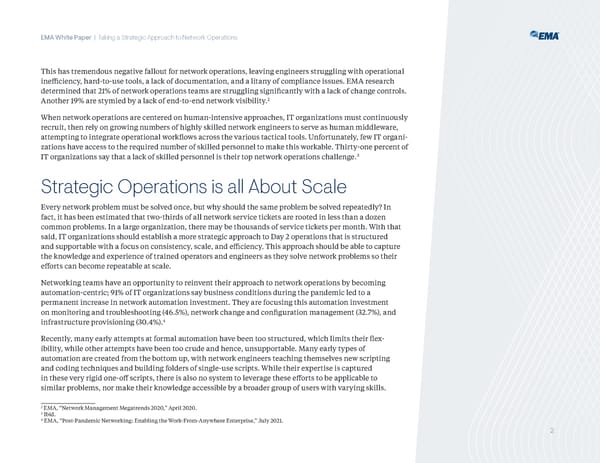EMA White Paper | Taking a Strategic Approach to Network Operations This has tremendous negative fallout for network operations, leaving engineers struggling with operational inefficiency, hard-to-use tools, a lack of documentation, and a litany of compliance issues ƒM† research determined that ŽŒ” of network operations teams are struggling significantly with a lack of change controls †nother Œ˜” are stymied by a lack of end-to-end network visibilityŽ hen network operations are centered on human-intensive approaches, IT organizations must continuously recruit, then rely on growing numbers of highly skilled network engineers to serve as human middleware, attempting to integrate operational workflows across the various tactical tools ™nfortunately, few IT organi- zations have access to the reuired number of skilled personnel to make this workable Thirty-one percent of IT organizations say that a lack of skilled personnel is their top network operations challenge“ Strategic Operations is all About Scale ƒvery network problem must be solved once, but why should the same problem be solved repeatedlyš In fact, it has been estimated that two-thirds of all network service tickets are rooted in less than a dozen common problems In a large organization, there may be thousands of service tickets per month ith that said, IT organizations should establish a more strategic approach to ˆay Ž operations that is structured and supportable with a focus on consistency, scale, and efficiency This approach should be able to capture the knowledge and experience of trained operators and engineers as they solve network problems so their efforts can become repeatable at scale etworking teams have an opportunity to reinvent their approach to network operations by becoming automation-centric› ˜Œ” of IT organizations say business conditions during the pandemic led to a permanent increase in network automation investment They are focusing this automation investment on monitoring and troubleshooting ‘œžŸ”’, network change and configuration management ‘“Ž¡”’, and œ infrastructure provisioning ‘“‹œ”’ ¢ecently, many early attempts at formal automation have been too structured, which limits their flex- ibility, while other attempts have been too crude and hence, unsupportable Many early types of automation are created from the bottom up, with network engineers teaching themselves new scripting and coding techniues and building folders of single-use scripts hile their expertise is captured in these very rigid one-off scripts, there is also no system to leverage these efforts to be applicable to similar problems, nor make their knowledge accessible by a broader group of users with varying skills Ž ƒM†, “etwork Management Megatrends Ž‹Ž‹,” †pril Ž‹Ž‹ “ Ibid œ ƒM†, “£ost-£andemic etworking¤ ƒnabling the ork-rom-†nywhere ƒnterprise,” ¥uly Ž‹ŽŒ 2
 EMA whitepaper Take A Strategic Approach To Network Operations Page 2 Page 4
EMA whitepaper Take A Strategic Approach To Network Operations Page 2 Page 4